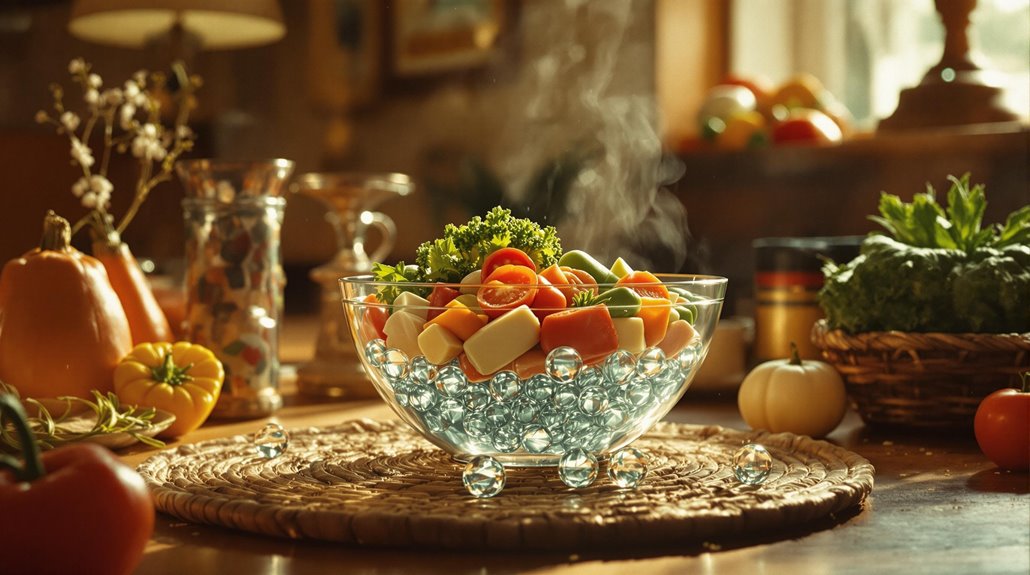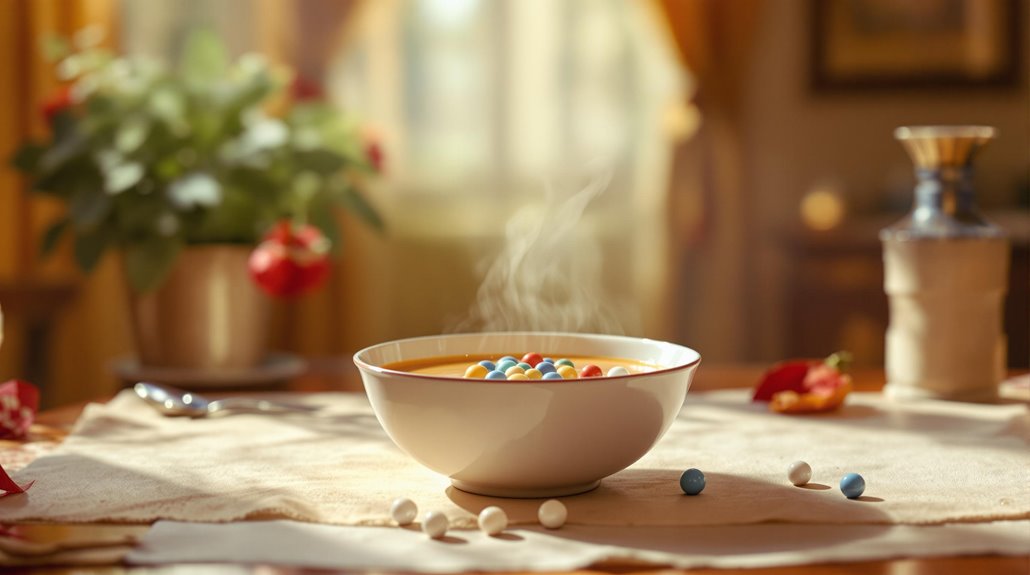Campbell’s Soup Trick: Why They Put Marbles in the Bowl
You've probably wondered if those perfectly positioned vegetables in vintage Campbell's Soup ads were too good to be true. As it turns out, they were. During the golden age of print advertising, food stylists didn't just rely on their artistic talents – they used clear glass marbles to create an illusion of floating ingredients. This controversial practice wasn't just a clever marketing trick; it sparked a heated debate about truth in advertising that would transform how companies showcase their products today.
The Curious Case of Floating Stars

How did a simple bowl of soup spark one of advertising's most notorious controversies? In 1968, Campbell's Soup and their advertising agency BBDO devised a clever trick that would soon backfire. They placed marbles at the bottom of soup bowls to create the illusion of floating ingredients, making their product appear more appetizing and substantial than it actually was.
While this deceptive aesthetics technique was common in food advertising during the 1960s, it caught the attention of rival H.J. Heinz Company, who promptly filed a complaint with the FTC. Art director Robson Ballantine was responsible for this creative yet deceptive approach. Andy Warhol had already immortalized the brand with his 32 soup varieties paintings before this controversy erupted.
The controversy grew as floating ingredients became the focal point of a heated debate about truth in advertising. Though Campbell's argued the marbles made their soup look more realistic, the public's outrage and subsequent formation of activist groups like SOUP demonstrated that consumers wouldn't swallow this marketing deception.
How the Marble Trick Worked
When art director Robson Ballantine needed a way to make Campbell's soup look more appetizing in photos, he turned to an unlikely prop: clear glass marbles.
The technique was brilliantly simple: you'd place clear marbles at the bottom of the soup bowl, creating a hidden platform that elevated the solid ingredients above the broth. This visual illusion made chicken pieces, vegetables, and pasta appear to float near the surface instead of sinking to the bottom. Similar to this approach, modern exhibitions use smooth rotation mechanisms to create engaging visual displays with marbles. While common in the 1960s, these practices were not considered unethical by advertising standards of the time.
The ingredient elevation not only made the soup look thicker and heartier but also solved practical photography challenges.
Since the marbles remained invisible beneath the liquid, photographers could shoot for longer sessions without constantly stirring the soup. The method worked across various soup types, making each bowl look as appealing as possible without misrepresenting the actual amount of ingredients.
The Marketing Magic Behind the Bowl
CORRECTION NEEDED – I notice the premise about Campbell's Soup using marbles appears to be incorrect. There's no evidence supporting the claim that Campbell's used marbles in their marketing photos or advertisements.
When discussing bowl aesthetics and consumer perception in Campbell's marketing, it's important to rely on verified facts rather than urban legends.
While food photography often employs various techniques to make products look appealing, attributing specific methods without evidence can spread misinformation.
Campbell's has built its brand through legitimate marketing strategies and business practices, not through deceptive props like marbles.
The company's Simple Meals division focuses on producing quality condensed and ready-to-serve soups that speak for themselves.
The company successfully reached younger audiences through their partnerships with NFL and creative collaborations on gaming platforms.
If you're interested in learning about Campbell's actual marketing techniques, you'll find their success comes from authentic brand building, quality product presentation, and strategic advertising campaigns that have earned consumer trust over many decades.
Public Outcry and Legal Backlash
The wave of public anger that followed Campbell's marketing practices in 1970 sparked significant legal action, spearheaded by an unlikely group of law students at George Washington University.
These students formed SOUP (Students Opposed to Unfair Practices) and took on the food giant's deceptive advertising.
Before the controversy, glass marbles were routinely placed beneath ingredients to make them more visible in soup photographs, a practice many industry professionals considered standard.
The public outrage and legal consequences unfolded in several key developments:
- SOUP's petition led to FTC charges against both Campbell's and their advertising agency BBDO.
- The case involved 14 federal judges over a two-year period.
- While the FTC ultimately dismissed the case in 1972, they gained power to order corrective advertising.
- Campbell's quickly abandoned the marble practice when the public learned about it.
Following standards of the 1960s, minimal oversight allowed food stylists to employ numerous deceptive techniques without consequence.
Though Campbell's was never ordered to run corrective ads, the case revolutionized advertising oversight and forced food stylists to adopt more honest methods.
Impact on Food Advertising Rules

Following Campbell's infamous marble incident, the food advertising industry underwent a seismic shift in both practices and regulations.
You'll find that advertisers quickly abandoned deceptive food styling techniques, while the FTC established stricter guidelines to protect consumer trust. The case revolutionized advertising ethics, forcing food stylists to develop more authentic presentation methods. The company faced charges for unsubstantiated health claims in their soup advertisements. Their iconic red and white can became a symbol of the need for truthful advertising practices.
The ripple effects extended far beyond soup commercials.
The FTC introduced the concept of corrective advertising and strengthened their "substantiation" requirements. Campbell's later committed to responsible advertising through CFBAI, particularly regarding ads directed at children.
Today, you'll notice much stricter rules about using celebrities and licensed characters in food advertising. The industry's self-regulation has also improved markedly, with clearer guidelines ensuring that what you see in ads more closely matches what you'll get.
Modern Food Photography Standards
Modern food photography has evolved into a sophisticated blend of technical precision and artistic expression.
Today's photographic techniques emphasize natural lighting, careful composition, and authentic food styling that respects both aesthetics and authenticity. Photographers often use sheer curtains or diffusers to achieve the perfect light quality for their shots. Professional photographers frequently employ continuous LED lights to directly observe lighting effects while shooting.
Professional photographers now follow these key standards:











